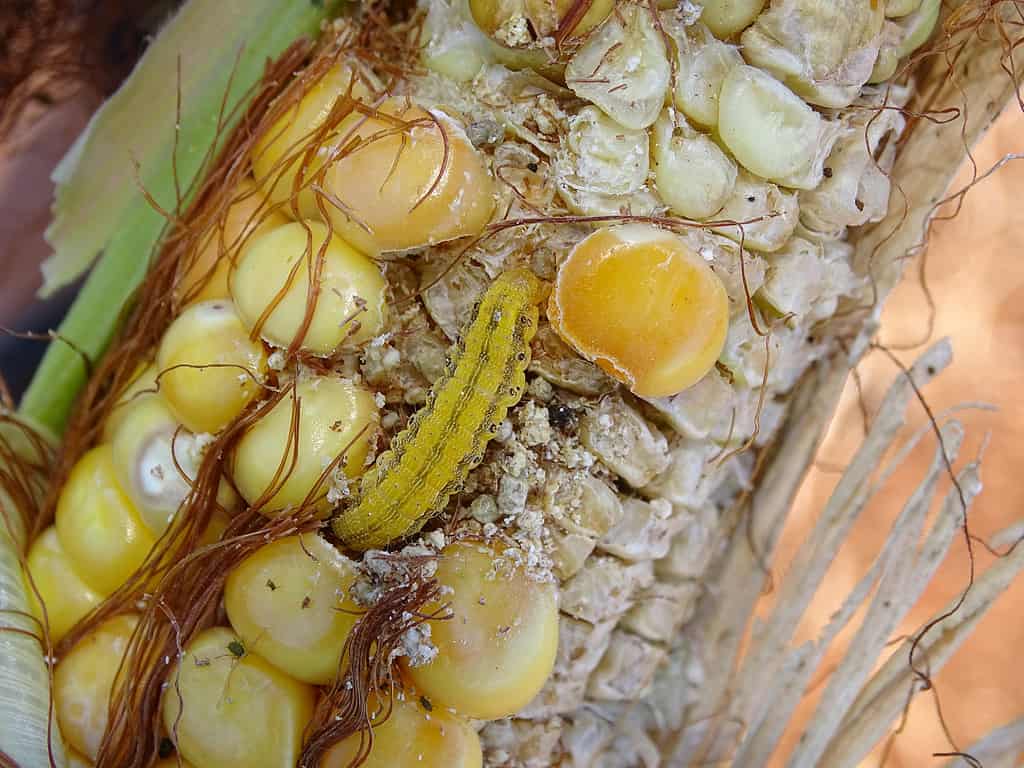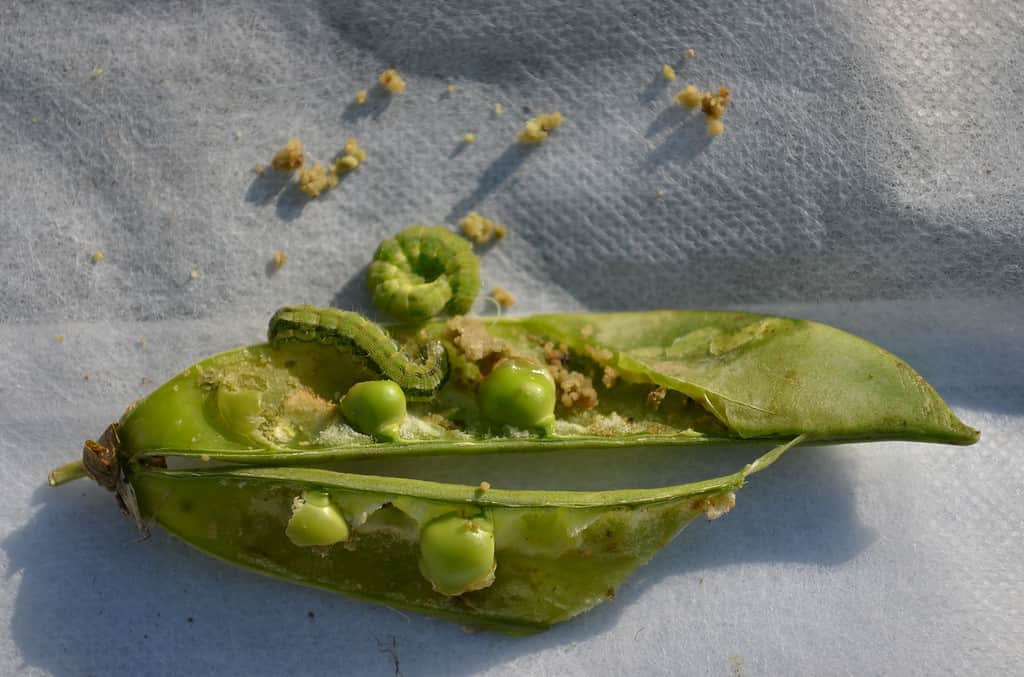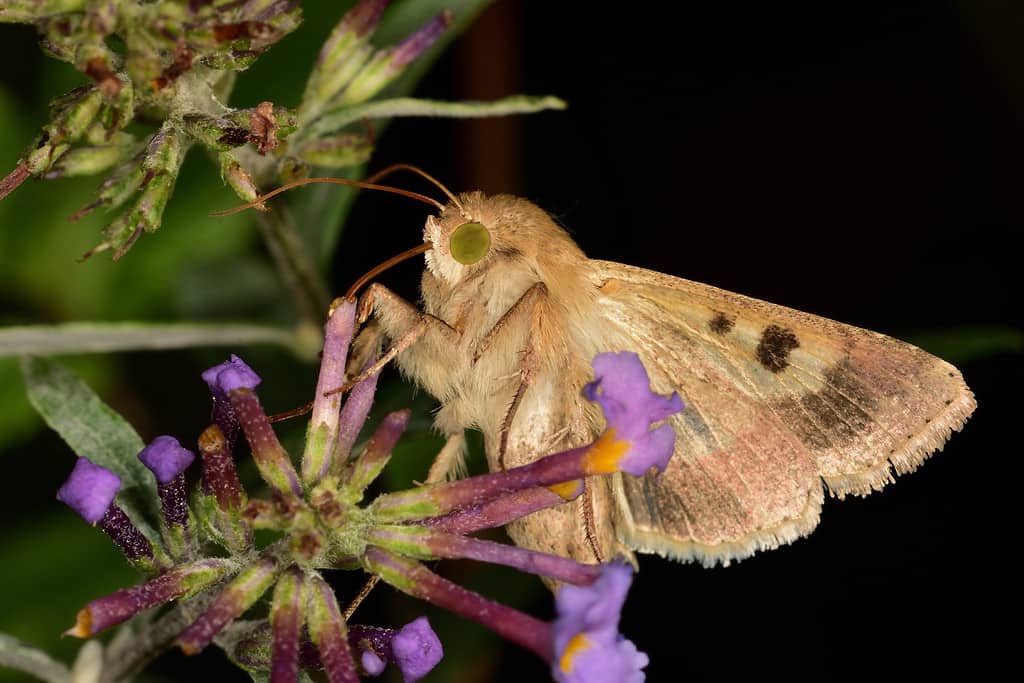Corn Earworm
The corn earworm is capable of devouring an entire crop in just a few days
Advertisement
Corn Earworm Scientific Classification
- Kingdom
- Animalia
Corn Earworm Facts
- Fun Fact
- The corn earworm is capable of devouring an entire crop in just a few days
- Distinctive Feature
- The presence of spines and small black spots displayed across its body.
- Other Name(s)
- Cotton bollworm, Tomato fruitworm
- Wingspan
- 2 inches
View all of the Corn Earworm images!
The corn earworm is an insect species of the moth family that is found in a wide range of crops that, include corn, cotton, and beans. It first appeared in Europe in 1886 and quickly traveled to a number of continents by 1890. These moths primarily inhabit South America, parts of Europe, and North America, except northern Canada and Alaska. Due to the harshness of winter, Corn earworms tend to migrate towards warmer climates as it provides them with an abundant food source, allowing this species to mature from caterpillar to moth.
4 Fun Facts
- The corn earworm is capable of devouring an entire crop in just a few days.
- Its larvae can be found in more than 200 different types of plants.
- The adult moths are active during the day when they fly around searching for food sources.
- Earworms have also been known to migrate over great distances which reach up to 398 miles!
Types of Corn Earworms Species

is the most prevalent and widespread corn earworm species in the United States and Canada.
©Marcos Cesar Campis/Shutterstock.com
The corn earworm, also known as Helicoverpa zea, is the only species known by its name. However, there are other closely related species within the same genus, called Helicoverpa, which are sometimes referred to as fruit worms.
There are several subspecies of corn earworms, which are listed below:
- Helicoverpa zea: Also known to be the most prevalent and widespread corn earworm species in the United States and Canada.
- Helicoverpa armigera: Although it was recently discovered in North and South America, this species is native to Africa, Asia, Europe, and Oceania.
- Helicoverpa assulta: This species is found in Asia, from the Indian subcontinent to eastern Asia.
- Helicoverpa punctigera: Australia and areas of Southeast Asia are home to this species.
In addition, all four of these species resemble one another in terms of appearance and behavior, and they all feed on a variety of crops, including corn, cotton, tomatoes, and soybeans.
The Scientific Name of the Corn Earworm
The corn earworm is an insect that belongs to the family Noctuidae, which represents a family of moths. Helicoverpa zea is its scientific name.
The Appearance of the Corn Earworm

The corn earworm caterpillars can be various shades including green, pinkish-brown, and black.
©iStock.com/Bhupinder Bagga
The larvae of the corn earworm are tiny, slender caterpillars displaying a variety of colors that include green, pinkish-brown, and sometimes even black. It has three pairs of legs near its head and five pairs of prolegs near its tail. In addition, the tail end of their body consists of a couple of black spots. The larvae can grow up to 1 1\2 inches long when fully grown.
Upon completing their growth, they will form a cocoon and transform into an adult moth. The adult moth can be identified by its unique creamy yellow to olive-tan color tones followed by black stripes, as well as a white spot on its wings. The adult moth measures roughly 1.5 inches in length, boasting a wingspan of up to 2 inches.
Habitat of the Corn Earworm
The corn earworm has a diverse food host range that includes grassy areas, wooded areas, and agricultural fields. Its cultivated hosts consist of:
- Sweet corn
- Field corn
- Green beans
- Eggplant
- Peas
- Peppers
- Lettuce
- Sweet potato
- Rice
- Cotton
- Grapes
- Strawberries
Diet
The larvae of the corn earworm feed voraciously on various plants, particularly flowers, foliage, and vegetables. However, it is especially fond of corn, thus giving it the name corn earworm, derived from its habit of feeding on sweet corn ears.
Adult moths indulge in pollen and nectar found in flowers. Apart from plant material, these ravenous eaters also feast on insects such as aphids and caterpillars.
Lifecycle of the Corn Earworm

The corn earworm moth is usually brown or gray and has a wingspan of about 1.2-1.5 inches.
©Davide Bonora/Shutterstock.com
The duration of their life cycle can vary from 30-50 days, depending on temperature and other environmental factors. In addition, it has a life cycle that consists of four stages that include: egg, larva, pupa, and adult.
Egg: The female moth lays between 500 and 1000 eggs on the surface of leaves, maize silk, or other plant parts. The eggs are typically cream or yellowish in color and have a diameter of about 0.5 mm.
Larva: When the eggs hatch after 2-10 days, the larva emerges and starts to feed on the host plant, which can either include corn, cotton, and tomato plants. The larva is typically green, yellow, or brown in color, with a distinct head that has two black spots.
Pupa: After about 2 to 3 weeks of feeding, the larva pupates and forms a cocoon in the soil or in plant debris. The pupa is usually brown or reddish-brown and about 1 cm long.
Adult: After about 1 to 2 weeks of pupation, the adult moth emerges from the cocoon. The moth is usually brown or gray and has a wingspan of about 1.2-1.5 inches.
Prevention of Infestation
Below are some guidelines on how to eradicate an infestation of corn earworm and how to prevent this species from reoccurring.
- Remove any damaged or infested fruit or vegetables from the plant and dispose of them properly.
- Inspect the plant regularly for eggs and caterpillars. Corn earworms are usually found on the leaves, stems, or fruit of the plant. You can remove them by hand or use a soft brush to gently brush them off the plant.
- Apply insecticides; there are several insecticides available that can help control corn earworms, including pyrethroids, carbamates, and organophosphates. Follow the instructions carefully when using any insecticide, and wear protective clothing as recommended.
- Incorporate natural enemies of corn earworms. Their natural enemies include parasitic wasps, ground beetles, and birds. You can draw these predators to your garden by planting nectar-producing flowers or offering bird nesting sites.
- You can use physical barriers like netting, or row covers to stop adult moths from depositing their eggs on the plants.
Corn Earworm FAQs (Frequently Asked Questions)
What does a corn earworm look like?
The larvae of the corn earworm are tiny, slender caterpillars displaying a variety of colors that include green, pinkish-brown, and sometimes even black. It has three pairs of legs near its head and five pairs of prolegs near its tail. In addition, the tail end of their body consists of a couple of black spots. The larvae can grow up to 1 1\2 inches long when fully grown.
What is the habitat of the corn earworm?
Grassy areas, wooded areas, and agricultural fields.
What do corn earworm eat?
The larvae of the corn earworm feed voraciously on various plants, particularly flowers, foliage, and vegetables. However, it is especially fond of corn, thus giving it the name corn earworm, derived from its habit of feeding on sweet corn ears.
Thank you for reading! Have some feedback for us? Contact the AZ Animals editorial team.
Sources
- Safer Brand, Available here: https://www.saferbrand.com/advice/insect-library/garden-insects/corn-earworms
- University of Illinois, Available here: https://ipm.illinois.edu/fieldcrops/insects/corn_earworm.pdf
- University of Maryland, Available here: https://extension.umd.edu/resource/corn-earworm-vegetables
- Wikipedia, Available here: https://en.wikipedia.org/wiki/Helicoverpa_zea

















